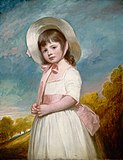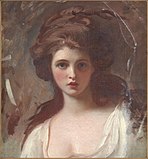George Romney
(26 December 1734 – 15 November 1802) was an English portrait painter. He was the most fashionable artist of his day, painting many leading society figures – including his artistic muse, Emma Hamilton, mistress of Lord Nelson.[1][2]
18세기말 영국 상류사회에서 인기를 끌었던 초상화가.
롬니가 그린 초상화에서는 모델의 성격이나 감정이 전혀 나타나지 않는다. 그가 상류사회후원자들에게 큰 인기를 누린 것은 바로 감정에 좌우되지 않고 아첨할 줄 아는 이런 능력 덕분이었다. 그의 초상화에서는 색채보다 선이 우세하다. 고대 로마 조각품의 흐르는 듯 매끈한 율동과 편안한 자세가 그의 그림이 갖고 있는 매끄러운 구도의 토대를 이루고 있다.
1755~57년 롬니는 떠돌이 초상화가이자 풍속화가인 크리스토퍼 스틸에게서 그림을 배웠다. 롬니는 영국 북부 지방을 돌아다니며 한 장에 몇 푼씩만 받고 초상화를 그려주면서 화가생활을 시작했다. 1762년에 런던으로 간 그는 역사를 주제로 한 〈울프 장군의 죽음 The Death of General Wolfe〉으로 미술협회에서
주는 상을 받았지만, 그럼에도 불구하고 즉시 초상화로 방향을 돌렸다. 1764년 파리를 처음으로 방문하여 조제프 베르네와 친구가 되었다. 롬니는 특히 니콜라 르 쉬외르의 작품에 감탄했는데 고전미술양식을 이용하는 르 쉬외르의 기법은 그를 강하게 매혹시켰다.
1773년에는 이탈리아로 가서 2년 동안 머물면서 바티칸의 스탄차에 있는 라파엘로의 프레스코와 베네치아에 있는 티치아노의 그림, 그리고 파르마에 있는 코레조의 그림을 연구했다. 해외여행으로 그의 미술은 완숙해져서 〈카워딘 부인과 아들 Mrs. Carwardine and Son〉(1775) 같은 초상화에는 새로운 우아함이 나타나 있으며, 전신 초상화인 〈크리스토퍼 경과 사이크스 부인 Sir Christopher and Lady Sykes〉(1786)에 신중하게 표현된 우아함이 나타나 있다.
롬니는 천성적으로 예민하고 내성적이었다. 그는 왕립 아카데미나 동료 화가들과는 어울리지 않고 철학계와 문단에서 친구를 사귀었다. 1781~82년경에 그는 에마 하트(뒤에 해밀턴 부인)를 만나, 에마의 매력에 병적으로 사로잡혔다. 롬니에게 에마는 상상 속의 이상세계로 탈출할 수 있는 수단이 되었다. 그의 〈거룩한 에마 Divine Emma〉는 술을 마시며 흥청대는 여자로부터 잔 다르크에 이르기까지 다양한 모습으로 묘사되어 50점이 넘는 작품에 등장한다. 이것은 거의 모두 실물을 보지 않고 기억에 의존하여 그린 작품이었다.
Early life and training

Romney was born in Beckside in Dalton-in-Furness, Lancashire (now part of Cumbria), the 3rd son (of 11 children) of John Romney, cabinet maker, and Anne Simpson. Raised in a cottage named High Cocken in modern-day Barrow-in-Furness, he was sent to school at nearby Dendron. He appears to have been an indifferent student and was withdrawn at the age of 11 and apprenticed to his father's business instead.
He proved to have a natural ability for drawing and making things from wood – including violins (which he played throughout his life). From the age of 15, he was taught art informally by a local watchmaker called John Williamson, but his studies began in earnest in 1755, when he went to Kendal, at the age of 21, for a 4-year apprenticeship with local artist Christopher Steele – a portraitist who had himself studied with distinguished French artist Carlo Vanloo. All costs were to be borne by George's father.
In October 1756, Romney married Mary Abbot (a decision he initially regretted), but the couple were immediately separated when he was called away to York on business by his employer. After a year, Steele eventually agreed to cancel the apprenticeship, at George's request, leaving the young artist – now a father of a son – free to pursue his own career as a painter.[3]
Work[edit]
Cumbria[edit]
In 1757, Romney rejoined his wife and young son in Kendal, working as a portraitist, landscape and historical painter. In this period he became friends with Adam Walker, the inventor and writer, and also pursued musical interests in his spare time. In March 1762, he parted from his wife, son and daughter (the latter dying in 1763), to seek his fortune in London, where he stayed (apart from a few return visits to Cumbria) until 1799. Throughout the separation, he maintained contact with his family and financially supported them, but they never lived with him in the capital.
London[edit]
In 1763, Romney entered his painting, The Death of General Wolfe, into a Royal Society of Arts competition. According to friends of Romney, he was awarded the second prize of 50 guineas, but this was later to reduced to 25 guineas on questionable grounds. It is said that Sir Joshua Reynolds himself was the prime mover behind this decision, a fact which may have accounted for the lifelong aversion of the two men for each other.
Despite his later success, Romney was never invited to join the Royal Academy of Arts (formed 1768), though he was asked, urged even, to exhibit there – nor did he ever apply to join. This decision certainly cost him valuable royal patronage and support from others connected at court. While there has been much speculation about his actual relationship with the Academy, there is no doubt that he normally remained aloof, maintaining that a good artist should succeed without being a member. His own career supported this belief, and it was only towards the end of his life that he expressed the slightest regret for his views.[4]
His early years in the capital were something of a struggle financially. In September 1764, he travelled to Paris (with a friend, lawyer Thomas Greene) for a few weeks to study the works of the old masters (travel abroad was seen as a requisite of a developing artist's training as the opportunity to view great art in London was very limited). In 1765 he again won the second prize of 50 guineas in the Royal Society of Arts competition. In 1768, he made the acquaintance of Richard Cumberland, the dramatist, whose portrait he painted, and who was helpful in introducing him to influential patrons. He also became friends with miniature painter Ozias Humphrey.
1769 was a breakthrough year – he exhibited a large portrait of Sir George Warren and family at the Free Society of Artists, which was greatly admired and helped to lay the foundations of his future popularity. In 1770 he started to exhibit his work at the Chartered Society of Artists rather the rival "Free Society of Artists".
Italy
By 1772 Romney was financially secure enough to make the journey (with Ozias Humphrey) to Italy to study the great artists of the past, as he had always intended. He set off in March, making his way through Europe (via Paris, Lyon, Marseilles, Nice, Genoa, Livorno, Florence and Pisa) and arriving in Rome in June. A letter of introduction allowed him to meet the Pope, Clement XIV, who allowed him to set up scaffolding in the Vatican to study the frescoes of Raphael. He spent 18 months in Rome making studies and sketches of the great art works on view there. He returned to London in July 1775 (via Florence, Bologna, Venice, Parma, and Turin) after an absence of over 2 years.
Later career[edit]

On his return, in 1775, Romney moved to Cavendish Square, in a house formerly owned by noted portraitist Francis Cotes. He was considerably in debt, not only on his own account but also due to being saddled with the debt of his artistic but dissolute brother Peter. However, he was offered commissions by the Duke of Richmond and his circle of friends, which helped turn the tide of fortune permanently in the artist's favour. In 1776–77, he made the acquaintance of William Hayley, striking up a lasting friendship with the writer, and painting portraits for him.
1782 was the beginning of an important new chapter in Romney's life, for in that year he was first introduced to Emma Hamilton (then called Emma Hart) who became his muse. He painted over 60 portraits of her in various poses, sometimes playing the part of historical or mythological figures.[5] He also painted many other contemporaries, including fellow artist Mary Moser.
In 1797 Romney left his studio at 32 Cavendish Square, where he had worked for more than twenty years, to move to Holly Bush Hill in Hampstead. In Hampstead Romney embarked on a series of costly building projects, and sold the house two years later. Romney's House is now a Grade I listed building, and Romney is commemorated by a blue plaque placed on the property.
In the summer of 1799, his health broken, and after an absence of almost forty years, Romney returned to his wife, Mary, in Kendal. She nursed him during the remaining 2 years of his life until he died in November 1802. He was buried in the churchyard of St. Mary's Parish Church, Dalton-in-Furness.
George Romney is a kinsman of American businessmen and politicians George W. Romney (1907–1995) and Mitt Romney (born 1947); their ancestor Miles Romney was George Romney's first cousin.[6]
Public collections of works[edit]

Romney's work is on display at many museums and art Galleries in the UK, North America and elsewhere:
- UK and Ireland
- Abbot Hall Art Gallery (Kendal); Kendal Town Hall (Kendal); Ashmolean Museum (University of Oxford); Courtauld Institute of Art (London); Dorset County Museum (Dorchester); Dulwich Picture Gallery (London); National Portrait Gallery, London; National Maritime Museum (London); Tate Gallery (London); Wallace Collection (London); Falmouth Art Gallery; Fitzwilliam Museum (University of Cambridge); Dalton Castle; Manchester City Art Gallery; National Museum Cardiff; National Museums Liverpool; New Art Gallery (Walsall); National Galleries of Scotland; Somerville College, Oxford; Crawford Municipal Art Gallery (Ireland); Waddesdon Manor (Buckinghamshire).
- United States and Canada
- Ackland Art Museum (University of North Carolina); Art Gallery of the University of Rochester (New York); Art Institute of Chicago; Beaverbrook Art Gallery (New Brunswick); Blanton Museum of Art (University of Texas at Austin); Brigham Young University Museum of Art (Utah); Carnegie Museum of Art (Pittsburgh); Dallas Museum of Art; Detroit Institute of Arts; the Fine Arts Museums of San Francisco, Robert Hull Fleming Museum (University of Vermont); Frick Collection (New York City); Forsyth County Public Library Central Branch, Winston-Salem, North Carolina; the Getty Museum (Los Angeles); Harvard University Art Museums; Honolulu Museum of Art; Huntington Library (California); the Kimbell Art Museum (Fort Worth, Texas); the Los Angeles County Museum of Art; Metropolitan Museum of Art (New York City); Museum of Fine Arts, Houston (Texas); Museum of Fine Arts, Boston; National Gallery of Art (Washington D.C.); Norton Simon Museum (Pasadena, California); Philadelphia Museum of Art; Stan Hywet Hall and Gardens (Ohio); Wadsworth Atheneum (Hartford, Connecticut); Phoenix Art Museum (Phoenix, Arixona); National Gallery of Canada; Folger Shakespeare Library (Washington, D.C.).
- Elsewhere
- Dunedin Public Art Gallery (New Zealand); Hermitage Museum (St. Petersburg, Russia), Louvre (Paris, France); Musée des beaux-arts (Pau, France), National Gallery of Victoria (Australia), MASP (Brazil).
Gallery
Young Man with a Flute, late 1760s Dallas Museum of Art
Macbeth and the witches, 1785
John Henderson as Macbeth, c. 1787
Major General Sir Archibald Campbell K.B. of Inverneill, 1790–1792
'♣ 미술(美術) 마당 ♣ > - 화가[畵家]' 카테고리의 다른 글
| [스위스 상징주의 화가]아놀드 뵈클린 [Arnold Böcklin] (0) | 2019.05.08 |
|---|---|
| [이탈리아- 상징주의 화가]Gaetano Previati (0) | 2019.05.07 |
| [슈만, 리스트 등의 초상화를 그린 화가]Josef Kriehuber[요제프 크리후버] (0) | 2019.04.21 |
| [프랑스]Théodore Chassériau[테오도르 샤세리오] (0) | 2019.02.19 |
| [노르웨이- 풍경화의 아버지] Johan Christian Dahl (0) | 2019.01.31 |










